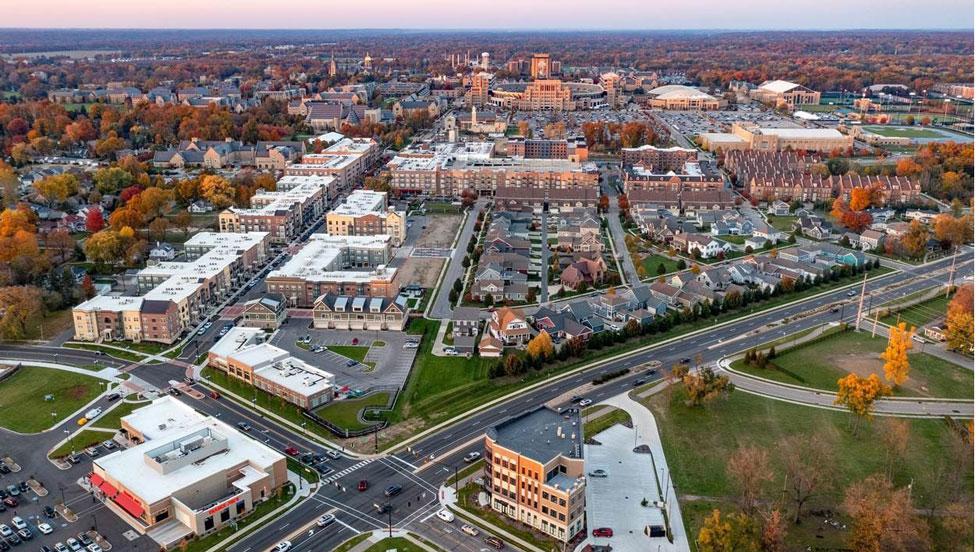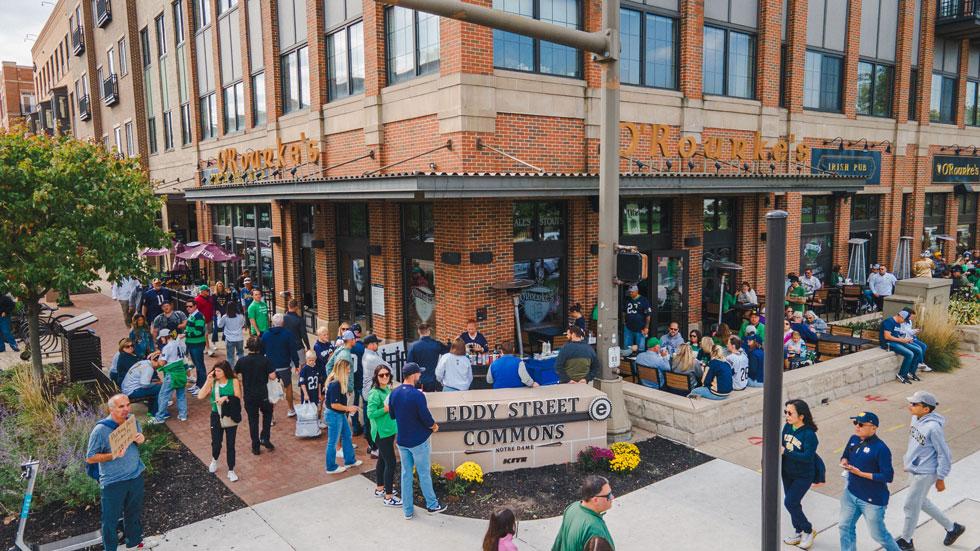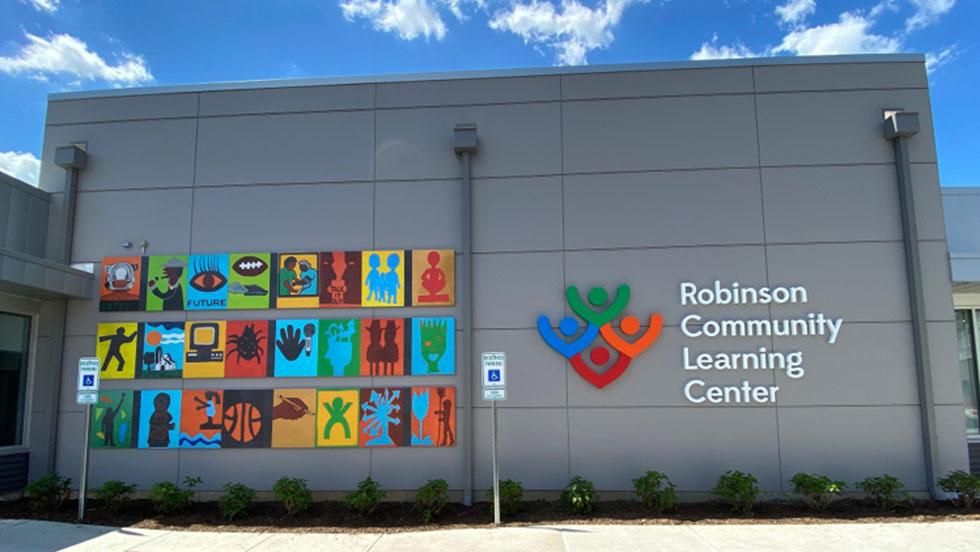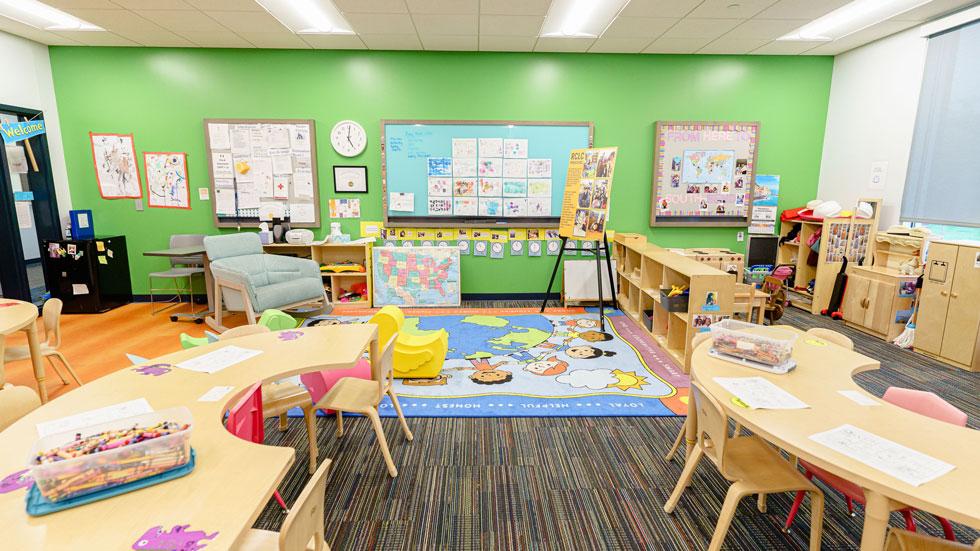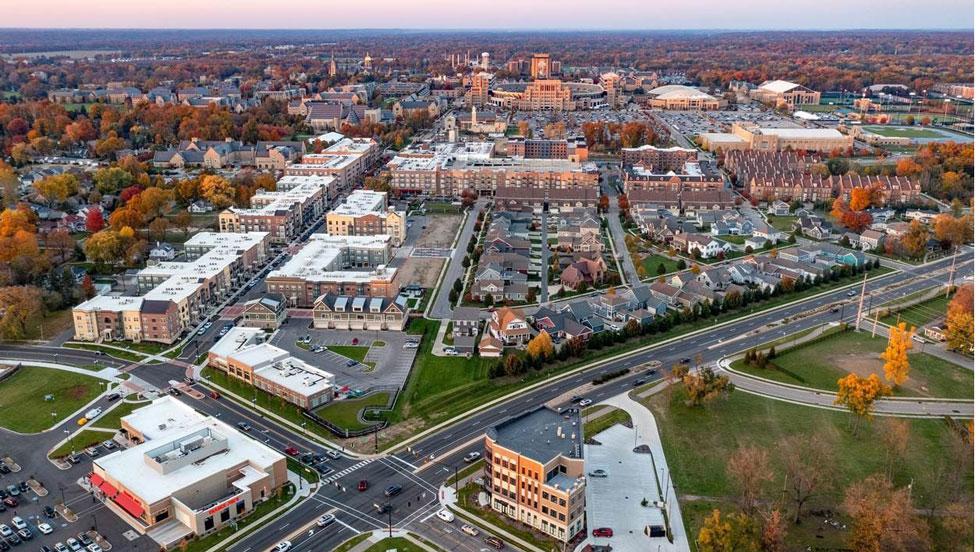
Despite plenty of headwinds in the past 20 years, including a deep global recession, a housing market crash, and a pandemic, a public-private partnership that includes Kite Realty Group (NYSE: KRG) pulled through to complete Eddy Street Commons, a walkable mixed-use development that serves the academic community at the University of Notre Dame, local residents, and the city of South Bend, Indiana.
Kite Realty Group (Kite) is an Indianapolis-based REIT that owns and operates shopping centers and mixed-use developments. The company’s primarily grocery-anchored portfolio is located in high-growth Sun Belt and select strategic gateway markets.
Tom McGowan, president and COO of Kite, says the planning for Eddy Street Commons goes back to 2005, when the University of Notre Dame decided to address long-term planning for the campus. “They wanted to close off city thoroughfares that separated the campus from adjacent neighborhoods and create a better sense of connection and community. That required buy-in from nearby residents.”
University leaders conceived the idea to establish a community across the street from Notre Dame, which already owned some of the land there. The area, which was once the site where coal ash was dumped from the university’s coal facilities, included an array of vacant and abandoned homes and lots.
Olive Branch Offering
Eddy Street Commons reflects the vision of Rev. Edward “Monk” Malloy, former president of Notre Dame, who founded the Northeast Neighborhood Revitalization Organization (NNRO) with the city of South Bend, St. Joseph Regional Medical Center, Memorial Hospital, and the Madison Center, a drug treatment center, in 2000.
“The Northeast neighborhood of South Bend had become an eyesore 25 years ago, with absent landlords, dilapidated homes, and safety issues,” says Tim Sexton, associate vice president for public affairs for the University of Notre Dame.
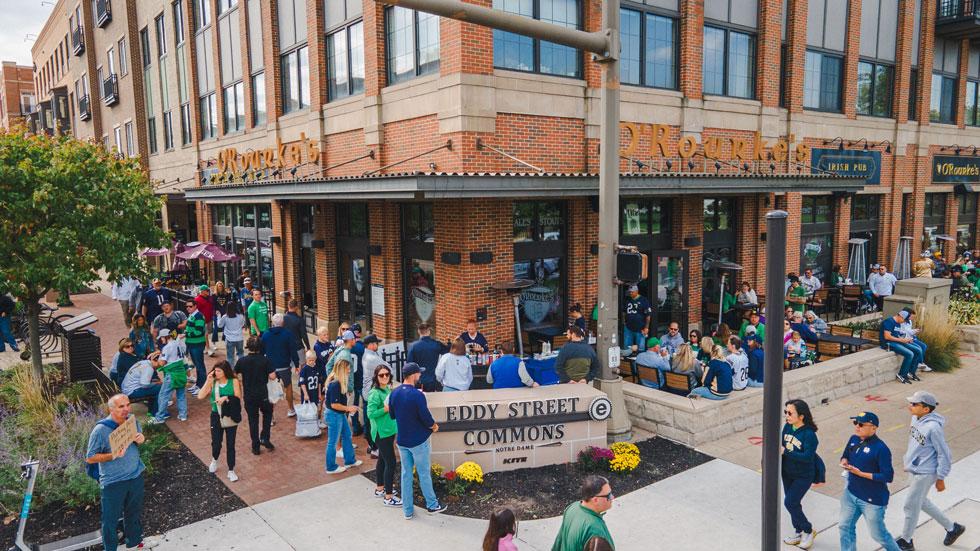
“Initially, the residents didn’t trust that the university had their best interests in mind. Notre Dame had the reputation that they historically looked after themselves. The first olive branch offered by the university was to build a community center for young kids and older adults in what had been an old grocery store,” he says.
Meanwhile, residents wanted to bring back single-family homes in the area, so Notre Dame built homes and convinced faculty and staff to live there permanently, not just as a “football weekend” place. “We had to offer to buy back the houses after a year, if people decided not to stay, and get the houses sold because there was a lot of concern about the neighborhood back then,” Sexton says.
The transformed area now includes more than 900 apartments, condos, and townhouses, two hotels, and retail and office space, all of which serve residents at Eddy Street Commons, Notre Dame students and faculty members, visitors to the university, and other South Bend residents.
In 2024, 2.7 million people visited Eddy Street Commons, according to data from Placer.ai. More than $315 million has been invested in the 750,000 square-foot mixed-use development, which generates an estimated $1.3 billion annual total economic impact in St. Joseph County, according to Kite.
Structuring the Deal
Kite was chosen to develop Eddy Street Commons from a pool of more than 50 companies that presented bids. The REIT hired an architect and planner in 2006, then went to the city to arrange financing.
“It was a nice structure we were able to arrange, with $36 million in tax increment financing (TIF) to build 90,000 square feet of retail space, 80,000 square feet of office space, 256 apartments, a 119-room hotel, and a garage with 1,253 spaces," McGowan says. “We used a significant portion of the funds to get the infrastructure in place. We were able to negotiate an agreement on the garage so that when the bonds are paid off the garage rent reverts to us.”
After Kite finalized their terms with South Bend, they needed to align with Notre Dame.
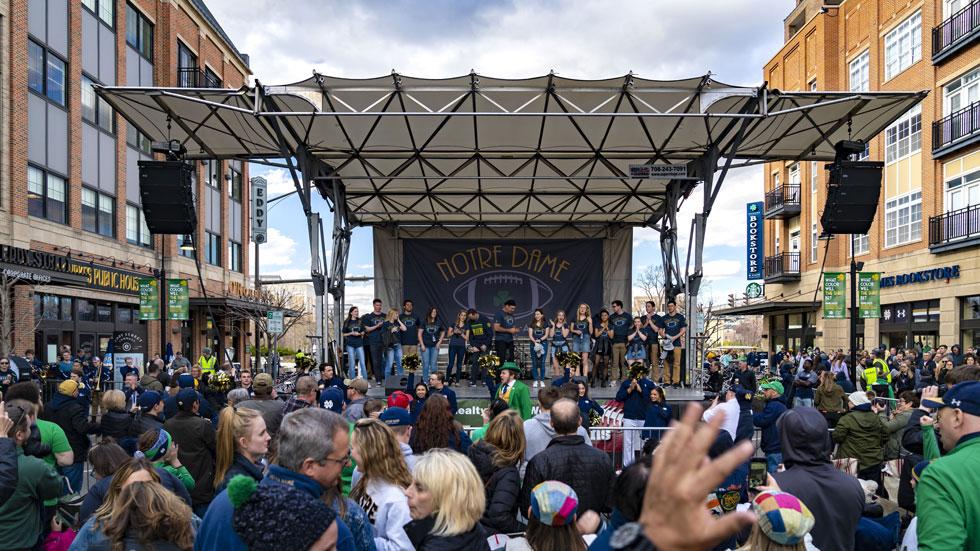
“A lot of universities have replicated the structure we created with Notre Dame, which was really the first major university joint venture project of its kind,” McGowan says. “It’s been a model throughout the country. We agreed to a long-term ground lease with the university, which was priced off a percentage of revenue. That way, if the hotels, retail, and office space did poorly, the university received less of a percentage for the land. If they did well, the university got a higher percentage of revenue. Luckily, we’ve been incredibly successful and economically it’s worked well for both the university and us.”
After the first phase was completed, Notre Dame opted to lease most of the office space. The condos at Eddy Street Commons have appreciated in value and are in high demand, McGowan says.
“We were ready to push the second phase of the project and develop two more city blocks with the full support of the university when Pete Buttigieg was mayor of South Bend,” McGowan says. “He wanted us to generate jobs before another TIF would be considered, so we built a 164-room Embassy Suites hotel, which created the desired, well-paying jobs.”
In addition to the hotel, which has a rooftop view of the Notre Dame football field and campus, Kite built another 452 apartments and 10,000 additional square feet of retail space.
During the third phase, 28 townhouses were added to Eddy Street Commons, along with a Trader Joe’s grocery store and 4,000 square feet of additional retail space.
“The Trader Joe’s is monumental for our community and South Bend,” Sexton says. “The neighborhood and the students are thrilled to have it here and it was a missing piece for the development.”
Numerous restaurants and retail stores are part of the mix, but Sexton says students pushed hard for an Urban Outfitters store, which became one of the first retailers at Eddy Street Commons.
Community Partnerships
While Sexton didn’t work for the university in the earliest planning stages for Eddy Street Commons, he says that Kite has always embraced the model of working collaboratively with neighbors, the university, and city leaders—including three different mayors.
“Representatives from Kite, including Tom McGowan, have been at countless meetings over the years, listening to everyone’s concerns, getting feedback and modifying plans as needed,” Sexton says. “Kite understood how important it was to partner with residents in the Northeast neighborhood, and the city, to get a win-win for everyone.”
During the planning stages of Eddy Street Commons, Kite worked to address community member concerns, such as parking and building heights.
“That’s one reason we designed the big garage, to avoid cars spilling out into residential streets,” McGowan says. “Then we wrapped the garage in condos, so no one was looking directly at it.”
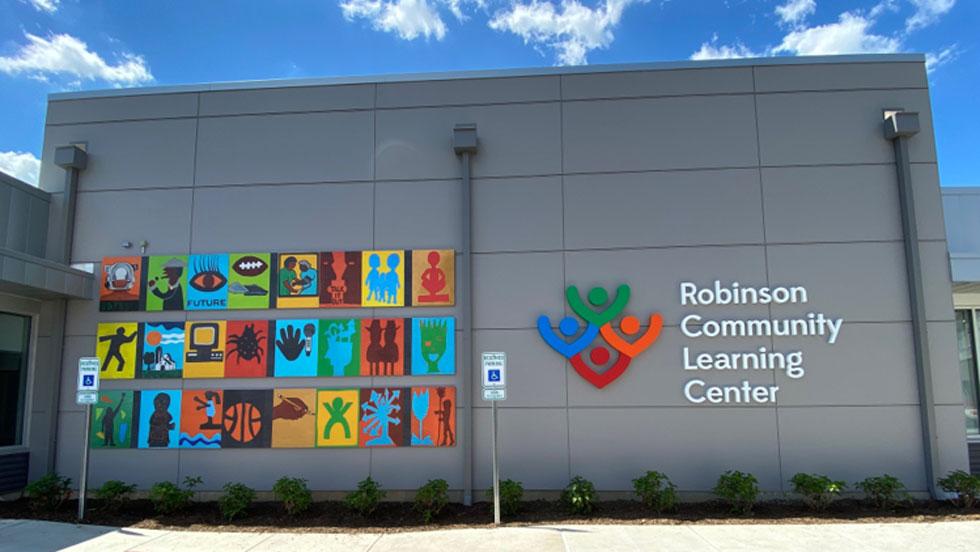
Kite added pocket parks and a dog park, plus they were careful to design buildings with reasonable heights and loading areas away from where noise would bother residents.
“Rev. Malloy wanted to bridge the disconnect that existed between the university and the community,” McGowan says. “As part of the land planning, the university created what they call the ‘Irish Green,’ a space that’s open and welcoming to everyone in the community, not just to the university.”
While South Bend, Notre Dame, and Kite were excited to create a new development that attracted visiting professors, alumni, new faculty, and students to the university, they were also committed to making Eddy Street Commons valuable to the existing community.
“We used $1.5 million of our TIF to provide roads and infrastructure for the Triangle, a redevelopment of a severely blighted area,” McGowan says. “This was a way to show people that this wasn’t just a place for alumni to buy condos. It was a give-and-take for people who were worried about establishing a permanent community in that neighborhood.”
The Triangle was redeveloped with 63 affordable single-family homes by the NNRO, with the commitment that at least 30% of those homes will be permanently designated as affordable housing.
“We’re also super proud that we built a brand-new building for the Robinson Community Learning Center, which was located in a dilapidated old grocery store, and was underfunded,” McGowan says. “Kite built the new community center at no cost and the university handles their operating expenses. So once again, this just shows the great relationship that we have with our partners.”
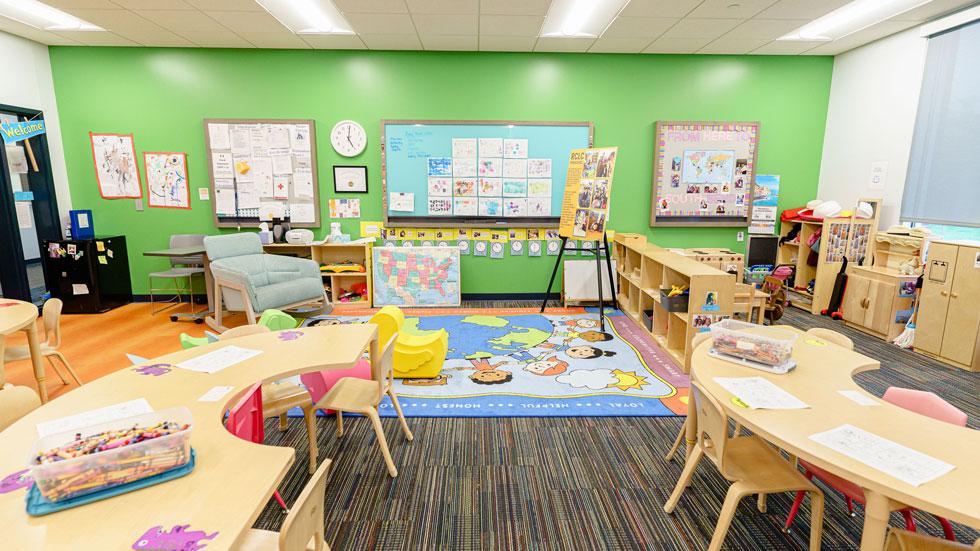
The Robinson Community Learning Center hosts education programs for all ages, including for about 2,000 youth, many of whom are underprivileged. Meanwhile, the new Eddy Street Commons building houses the Kite Black Box Theater, a makerspace collaborative technology lab, a state-of-the-art early childhood classroom, a podcast studio, a flexible meeting space/classroom, an industrial kitchen, an outdoor play area, and secure entrances for visitors and staff. Numerous volunteers support the activities at the center, including Notre Dame students and staff.
“Many Northeast residents were skeptical about Eddy Street Commons at first, including Marguerite Taylor, an original member of the NNRO whose mother was Renelda Robinson, the person the community center is named after,” Sexton says. “Marguerite is still actively involved in the NNRO and says this entire project has been a home run for her neighborhood.”
A Downtown for Everyone
Kite takes great pride in their mixed-use development, which is viewed as a model for its creative financing and partnerships with the university, local government, and nonprofit organizations.
“We’re also proud of our resilience, especially when we broke ground just as the financial crisis hit,” McGowan says. “One thing that’s interesting about working with Notre Dame is that the deal stretch was very long. The university looks 200 years out at their plans. And they didn’t want Eddy Street Commons to look just like the university. It was meant to be its own community connected to the campus.”
The connection between Eddy Street Commons and the university is strengthened through branding, with even the hotel named the Embassy Suites of South Bend at Notre Dame.
“It was well worth the time it took to get buy-in from the community and make it clear that this wasn’t just a project for the university,” McGowan says. “Eddy Street Commons’ retailers draw customers from the community, the university, South Bend, and visitors. But I think the best part is the Robinson Center, which has these amazing programs that are great for kids, adults, and the university students who volunteer there.”
